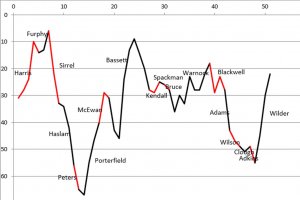The Bohemian
Member
- Joined
- Jul 24, 2012
- Messages
- 525
- Reaction score
- 2,522
The last ‘great’ Blades team, prior to the current one, in my lifetime was in the John Harris\Ken Furphy era, spanning 1969-1975. “Great”, in Blades terms, defined by making a successful transition to the top flight while playing an aesthetically pleasing style of football.
Harris’ team won promotion in 1971 and then went unbeaten in its first 10 games, racing to the top of the old First Division. The wheels came off, somewhat, after being beaten by George Best in a 2-0 defeat at Old Trafford but ‘United’ still finished in a respectable 10th position. Harris moved ‘upstairs’ in December 73, replaced by Ken Furphy. The Blades remained a mid-table, First Division team for 4 seasons, culminating in a 6th place finish in 1975 – an achievement only bettered on three occasions in the last 100 years (when finishing 5th in 1924, 26 and 62).
The 11 players who epitomised that period, for me, are:
Hodgkinson (576 apps)
Badger (458 apps)
Hemsley (247 apps)
Flynn (190 apps)
Colquhoun (363 apps)
Salmons (180 apps)
Woodward (536 apps)
Hockey (68 apps)
Dearden (175 apps)
Currie (313 apps)
Reece (210 apps)
Hockey makes it into the line-up, despite a relatively short Blades career, due to his key role as Currie’s minder in the 1971 promotion winning team.
Goalkeeper, Hodgkinson was at the end of his career and replaced by John Hope, in the 1971 promotion winning season so didn’t play in the return to the top flight.
The Blades employed an exciting, expansive style of, “on the front foot”, football, attacking down both wings, with both full-backs encouraged to get forward. Currie ran the show from centre mid and developed a telepathic understanding with Woodward.
Despite finishing the season as runners-up, Harris’ team were comfortably the division’s top scorers, while remaining frugal in defence. Only champions, Leicester conceded fewer goals.
My comparative, current day, 11 – again chosen on the basis of playing a key role in the transition from 2nd to top tier – is:
Henderson (70 apps)
Baldock (85 apps)
Stevens (117 apps)
Basham (254 apps)
Egan (69 apps)
O’Connell (162 apps)
Norwood (71 apps)
Fleck (155 apps)
Duffy (111 apps)
Sharp (207 apps)
McGoldrick (69 apps)
Duffy makes it over Lundstram - despite being moved on following promotion - due to his more influential role in the promotion winning team.
In terms of similarities, the glaringly obvious one is in the stability of the two line-ups, measured by numbers of appearances. The 60s/70s team averaged a staggering 300+ appearances per player. Even from an age where players moved club less frequently, this is an extraordinary statistic. By comparison, the ‘current’ roster has already notched up an average of 123 appearances with, hopefully, plenty more to come.
Harris, like Wilder, saw the value of having a settled team with players who understood and trusted each other.
Harris built his team from a combination of home-grown talent (Hodgkinson, Badger, Salmons and Woodward) and astute, value signings (Hemsley, Flynn, Reece, Dearden and Hockey). Significant money, (bearing in mind the record transfer fee at the time was £150k spent by Leicester City on Allan Clarke), was invested in signing Currie from Watford (£26,500) and Colquhoun (£27,500) from West Brom. Currie was a young player deemed to have outstanding potential; Colquhoun was an established, highly rated centre half, who’d already proven himself in Division One.
Wilder employed a similar approach in building his promotion winning team; focusing mainly on younger players with raw attributes, who he felt could be improved (Henderson, Baldock, Stevens, Fleck, O’Connell and Egan).
1968 was a critical year of recruitment in building the successful team of the seventies, with Hemsley, Colquhoun and Currie joining a squad, which already included Hodgkinson, Badger, Salmons, Woodward and Reece. Fifty years later, in 2018, Wilder signed Henderson, Egan, Norwood and McGoldrick prior to storming to promotion.
A notable point of difference in the two eras is the relative lack of home-grown talent in the current group, with only Billy coming through the ranks.
Wilder has also had the luxury of being able to spend big following promotion – an option unavailable to John Harris during an era which preceded the riches of the Premier League.
A word of noteworthy caution from the 70s era:
In 1976, one year after that 6th placed finish, the Blades were relegated, not returning to the top flight until 1990, under Dave Bassett. From that ‘great’ team: Badger, Hemsley, Colquhoun, Flynn, Currie, Woodward and Dearden all played their last game for the Blades in the two years between 1976-78. The successful 70s team, assembled in a relatively short period, had - with the exception of Currie who was sold to Leeds - grown old together without being effectively replaced.
Harris’ team won promotion in 1971 and then went unbeaten in its first 10 games, racing to the top of the old First Division. The wheels came off, somewhat, after being beaten by George Best in a 2-0 defeat at Old Trafford but ‘United’ still finished in a respectable 10th position. Harris moved ‘upstairs’ in December 73, replaced by Ken Furphy. The Blades remained a mid-table, First Division team for 4 seasons, culminating in a 6th place finish in 1975 – an achievement only bettered on three occasions in the last 100 years (when finishing 5th in 1924, 26 and 62).
The 11 players who epitomised that period, for me, are:
Hodgkinson (576 apps)
Badger (458 apps)
Hemsley (247 apps)
Flynn (190 apps)
Colquhoun (363 apps)
Salmons (180 apps)
Woodward (536 apps)
Hockey (68 apps)
Dearden (175 apps)
Currie (313 apps)
Reece (210 apps)
Hockey makes it into the line-up, despite a relatively short Blades career, due to his key role as Currie’s minder in the 1971 promotion winning team.
Goalkeeper, Hodgkinson was at the end of his career and replaced by John Hope, in the 1971 promotion winning season so didn’t play in the return to the top flight.
The Blades employed an exciting, expansive style of, “on the front foot”, football, attacking down both wings, with both full-backs encouraged to get forward. Currie ran the show from centre mid and developed a telepathic understanding with Woodward.
Despite finishing the season as runners-up, Harris’ team were comfortably the division’s top scorers, while remaining frugal in defence. Only champions, Leicester conceded fewer goals.
My comparative, current day, 11 – again chosen on the basis of playing a key role in the transition from 2nd to top tier – is:
Henderson (70 apps)
Baldock (85 apps)
Stevens (117 apps)
Basham (254 apps)
Egan (69 apps)
O’Connell (162 apps)
Norwood (71 apps)
Fleck (155 apps)
Duffy (111 apps)
Sharp (207 apps)
McGoldrick (69 apps)
Duffy makes it over Lundstram - despite being moved on following promotion - due to his more influential role in the promotion winning team.
In terms of similarities, the glaringly obvious one is in the stability of the two line-ups, measured by numbers of appearances. The 60s/70s team averaged a staggering 300+ appearances per player. Even from an age where players moved club less frequently, this is an extraordinary statistic. By comparison, the ‘current’ roster has already notched up an average of 123 appearances with, hopefully, plenty more to come.
Harris, like Wilder, saw the value of having a settled team with players who understood and trusted each other.
Harris built his team from a combination of home-grown talent (Hodgkinson, Badger, Salmons and Woodward) and astute, value signings (Hemsley, Flynn, Reece, Dearden and Hockey). Significant money, (bearing in mind the record transfer fee at the time was £150k spent by Leicester City on Allan Clarke), was invested in signing Currie from Watford (£26,500) and Colquhoun (£27,500) from West Brom. Currie was a young player deemed to have outstanding potential; Colquhoun was an established, highly rated centre half, who’d already proven himself in Division One.
Wilder employed a similar approach in building his promotion winning team; focusing mainly on younger players with raw attributes, who he felt could be improved (Henderson, Baldock, Stevens, Fleck, O’Connell and Egan).
1968 was a critical year of recruitment in building the successful team of the seventies, with Hemsley, Colquhoun and Currie joining a squad, which already included Hodgkinson, Badger, Salmons, Woodward and Reece. Fifty years later, in 2018, Wilder signed Henderson, Egan, Norwood and McGoldrick prior to storming to promotion.
A notable point of difference in the two eras is the relative lack of home-grown talent in the current group, with only Billy coming through the ranks.
Wilder has also had the luxury of being able to spend big following promotion – an option unavailable to John Harris during an era which preceded the riches of the Premier League.
A word of noteworthy caution from the 70s era:
In 1976, one year after that 6th placed finish, the Blades were relegated, not returning to the top flight until 1990, under Dave Bassett. From that ‘great’ team: Badger, Hemsley, Colquhoun, Flynn, Currie, Woodward and Dearden all played their last game for the Blades in the two years between 1976-78. The successful 70s team, assembled in a relatively short period, had - with the exception of Currie who was sold to Leeds - grown old together without being effectively replaced.

